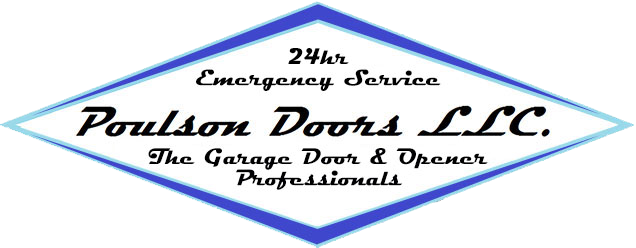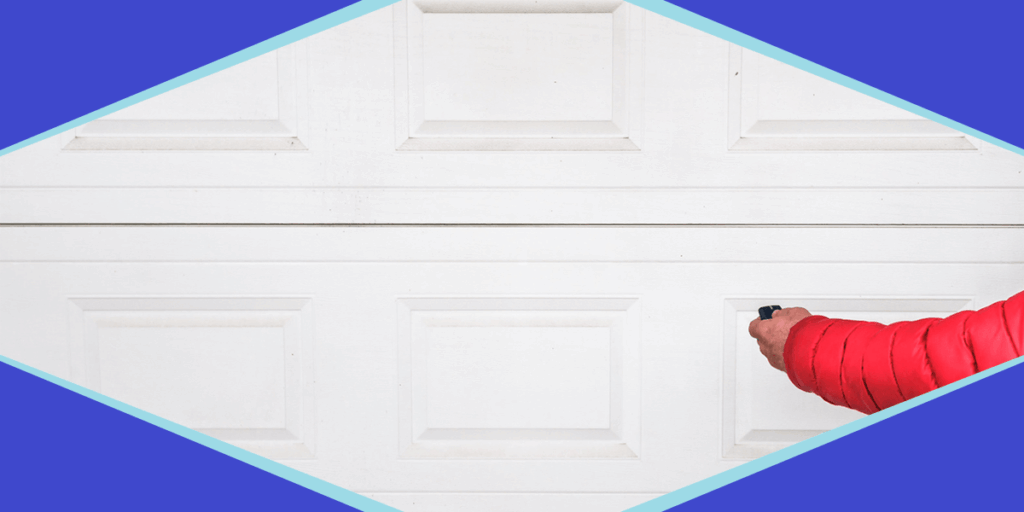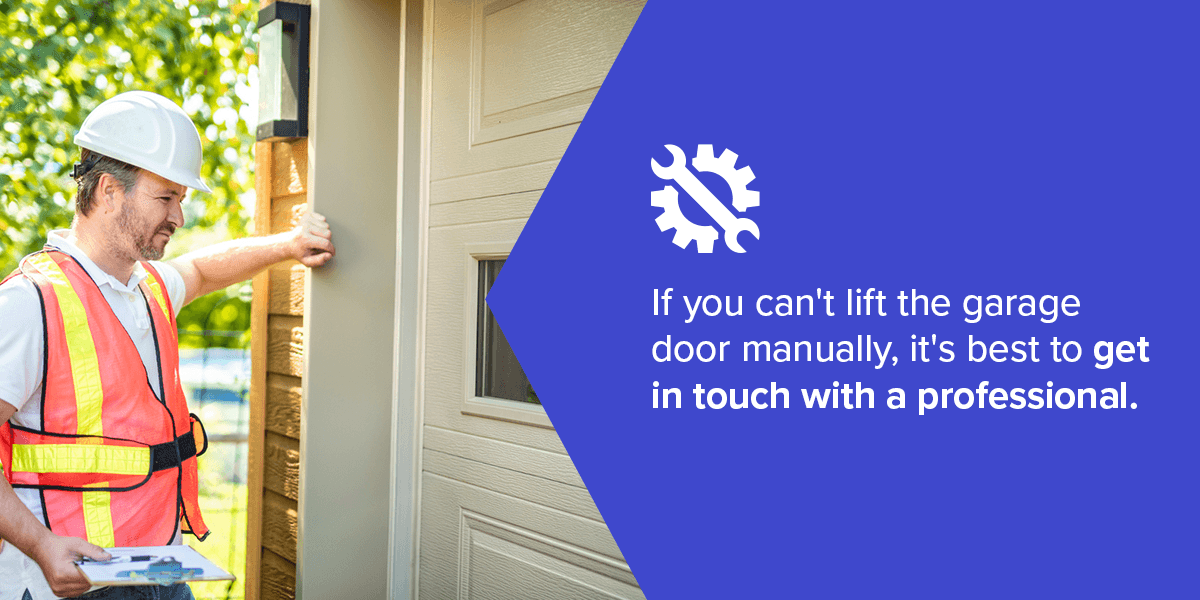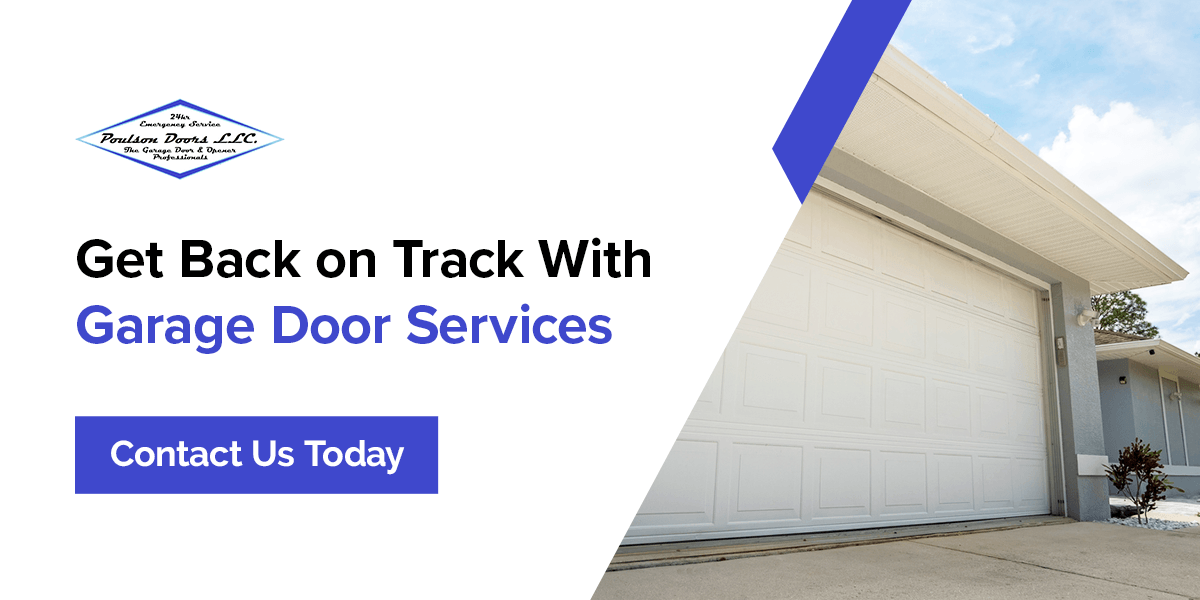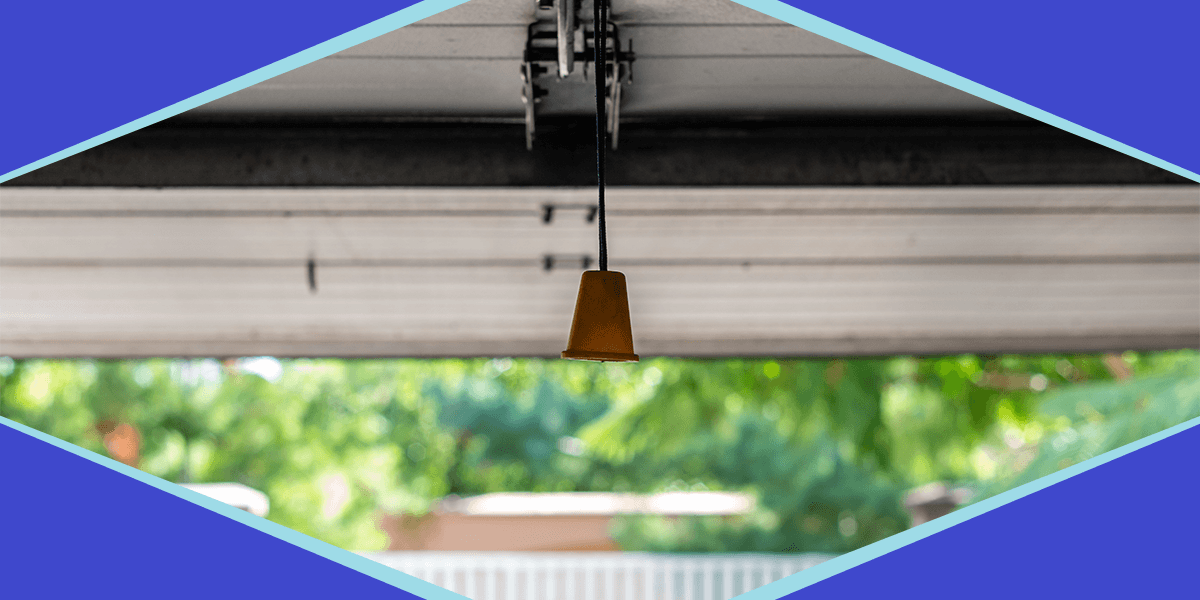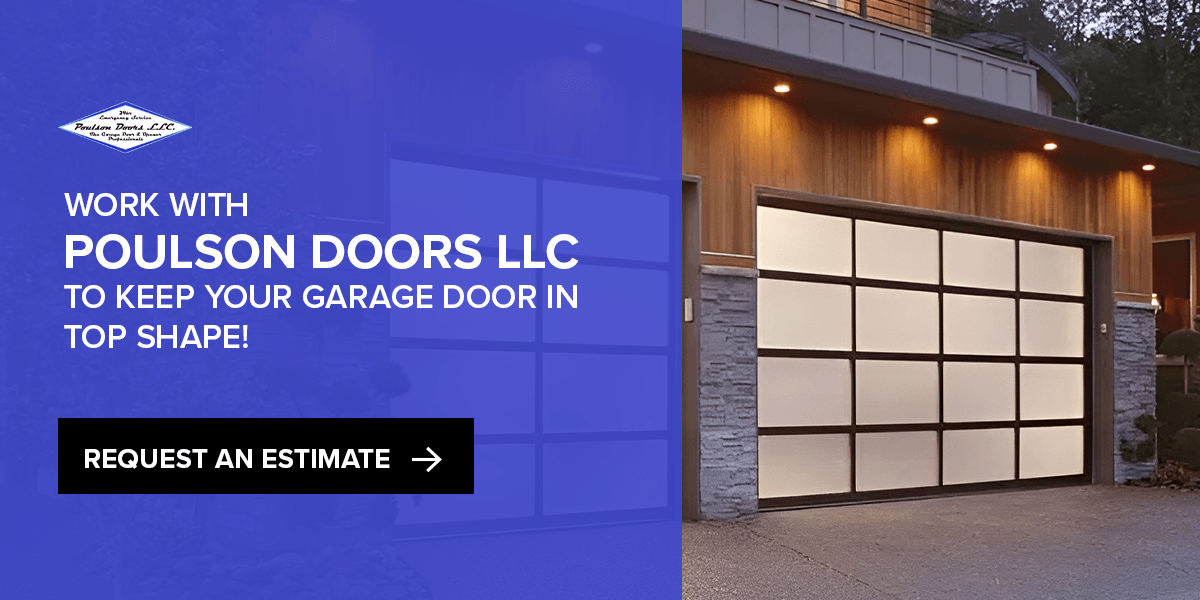How to Manually Open and Close Your Garage Door
After a long day, you pull into your driveway and press the garage door remote — and it won’t budge. Or maybe you’re rushing out, only to find the door stuck. Whether it’s the result of a power outage, a dead remote battery or a mechanical issue, a malfunctioning garage door can be frustrating.
You don’t have to be locked in or out of your garage while you wait for repairs. You can learn how to open and shut the garage door manually with this guide.
How to Manually Open or Close Your Garage Door From the Inside
It’s possible to open and close your garage door without a remote. However, there’s a significant pinch hazard when manually operating garage doors. It’s important to do it correctly to avoid injuring yourself. The first step is verifying that there are no mechanical issues before attempting to open or close the door, since damage increases safety risks. If you’re not sure whether you’re dealing with a broken door or not, stop and call a technician.
Manually Opening a Garage Door From the Inside
Follow these steps if you need to manually open a residential garage door from the inside:
- Disconnect the opener from electricity: If you have power in the household, start by unplugging the opener from electricity. This step will keep you safe in case the motor activates while you’re trying to open the door.
- Locate the emergency release: Find the red cord hanging from the garage door opener — it’s usually near the center of the ceiling. Before pulling the emergency release cord, make sure nothing is underneath the door, as a falling door can cause severe or even fatal injuries. Firmly pull the cord straight down to disengage the opener.
- Open the garage door: Grip the door with both hands and lift it. If the springs are in good condition, the door should move with minimal resistance. If you notice any resistance, stop immediately and seek professional help. A door that feels heavy in your hands could indicate a mechanical problem.
When you open the door, it should stay up until you close it. If it doesn’t, there could be a mechanical issue like broken pulleys and springs. If it falls back by itself, call your technician to fix the problem as soon as possible.
Manually Closing a Garage Door From the Inside
You can follow these steps to close your garage door manually:
- Pull the emergency release: Locate the red emergency cord hanging from the opener and pull it down to disengage the garage door from the automatic opener.
- Gently lower the door: Pull the garage door down until it reaches the ground. Lower it evenly to prevent it from coming off the tracks.
- Reconnect the trolley: Move the door along the track until it clicks into place.
One of the signs that your garage door needs urgent repair is the inability to close properly. Reach out to a professional to determine the issue and correct it.
How to Manually Open and Close Your Garage Door From the Outside
You’ll need the emergency key to open and manually close the garage door from the outside. Follow these steps to open it:
- Locate the emergency release mechanism: Look for a small keyhole near the top of the door. This keyhole is designed for manual operation from the outside. The key will open a kit that stores the emergency release cable.
- Unlock the door: Insert your key into the emergency release lock and turn it counterclockwise. Once the lock disengages, remove the key and tug the release cord toward you to unlock the garage door.
- Manually lift the door: With the lock disengaged, you should be able to lift the door with ease. If the door fails to open or it’s difficult, schedule repair services — there’s likely an issue with the moving parts.
To manually close the garage door from the outside, pull it down until it securely touches the ground. Then, you can use the key to lock the door securely.
What If You Can’t Manually Open Your Garage Door?
Garage doors work on spring and trolley systems that allow you to manually operate them and disengage from the automatic opener. While doors are heavy, you should be able to disengage and lift yours easily.
If you can’t lift the garage door manually, it’s best to get in touch with a professional. A few factors could be to blame.
1. Broken or Worn Springs
If you’ve followed this guide but are still unable to open your garage door, the most probable culprit is malfunctioning springs.
Springs are responsible for lifting the entire weight of your door. If there’s an issue with the springs, the door will be too heavy to lift by hand. Remember, if the springs are broken, do not attempt to replace them yourself or force the door open — this can cause injuries and further damage. Instead, call for professional spring replacement services to restore the door’s functionality.
2. Disconnected Release Cord
The red emergency release cord disengages the door from the opener. If you pull on it and it doesn’t detach from the opener, triggering manual operation, the release mechanism could be faulty. It may also be that the trolley is not in good working condition. Issues with the release cord and trolley system are best left to professionals.
3. Jammed Tracks
If the tracks are obstructed or bent, the rollers won’t slide well along them, making it challenging to open the door manually. Check for any debris or objects blocking the tracks and clear them before trying to reopen the door.
Confirm that the door has not come off its tracks, as misalignment could make manual operation challenging and risky. This could happen if the rollers are worn out or something has knocked the door off its path. If you notice any misalignment, call technicians to inspect the system and restore the door to its tracks.
4. Malfunctioning Opener
If the garage door opener is damaged or its internal gears fail, it may not correctly disengage when you pull on the emergency release. When that happens, your automatic garage door won’t close or open even with power on. If the opener is unresponsive, manually lifting the door may be impossible until it’s repaired.
Get Back on Track With Garage Door Services
If your garage door fails to operate with the remote control, opening and closing it manually is the best short-term solution while you wait for service. When you call a technician, let them know if you can’t operate it manually — they may be able to prioritize your repairs.
Remember that serious garage door failures like broken springs, misaligned tracks and loose or snapped cables require expert attention to ensure safe, reliable repairs. You also need instant repair services when you notice strange noises from the door or opener.
At Poulson Doors LLC, we know a malfunctioning garage door is more than an inconvenience. Reach out today to request a service appointment.
6 Reasons Your Garage Door Is Opening and Closing by Itself
You likely use your garage door several times a day to enter and leave your home or park your car. As with any mechanical and electric equipment, garage doors can sometimes malfunction. A garage door that opens and closes unexpectedly can be frustrating and present a safety and security hazard to your home.
You can stop your garage door from opening on its own by checking for common operational issues that can be quick to fix. If you notice complex electrical problems or damage, you’ll be better off getting a professional to intervene.
Possible Causes of Self-Opening and Closing Garage Doors
If your garage door opens by itself randomly, here are some of the most likely causes of the issue and a few do-it-yourself (DIY) solutions that may resolve it.
1. Remote Interference
The remote you use for your garage door can be triggered by neighboring remotes or radio interference. These devices may be emitting signals at the same frequency, which can interrupt the connection to your garage door. To prevent remote interference, try:
- Replacing the batteries.
- Reprogramming or resetting your garage door opener.
- Inspecting the garage door opener’s antenna for debris or damage.
- Repositioning the antenna on the garage door.
- Using a different frequency.
2. Sensor Malfunction
The two safety sensors on your garage door, sometimes called “eyes,” will open the door if they detect obstacles. If your garage door randomly opens, even with no obvious blockages, it might be due to malfunctioning safety sensors. Some safety sensors work by shooting a beam of light that must be connected for the garage door to operate properly, which can cause your door to reverse if it becomes misaligned.
Locate the sensor eyes at the bottom of the garage door and remove any debris, including leaves, that might block the sightline between the sensors. Use a cloth to clean any dust or dirt from the safety sensor lenses. If your garage door opener has a diagnostic panel, check for indications that the sensor beam is not operating correctly. If these troubleshooting steps don’t work, you may have another issue that requires assistance from a technician.
3. Wiring Issues
Your garage door has a small gauge wire that connects the motor unit to the opener on the wall and additional wires that connect the motor unit to the sensors. Faulty wiring or short-circuiting in any of these spots may be why your garage door opens on its own.
Exposed spots in these wires may be a result of a nail or staple piercing the wire, rodent issues or damage from garage equipment. Exposed wires can also potentially brush against the metal door track and activate the motor unit.
Examine the length of the wiring around the opener button to ensure it isn’t compromised. If you notice bare spots in the insulation along the wire, wrap them with electrical tape. If that doesn’t fix the issue, it’s best to call a garage door technician, as working with electrical wires can be dangerous and complex.
4. Mechanical Problems
If you’ve noticed your garage door randomly opens and closes and makes odd noises, you may have a mechanical issue. Here are some common garage door mechanical problems:
- Broken or worn-out springs
- Misaligned tracks
- Loose nuts and bolts
- Rust
- Damaged or loose rollers
A good way to identify the issue is by listening carefully to the noises your garage door makes. For example, if it makes a clinking noise, it might be rust. If you hear scraping and straining, it’s likely your springs. Grinding and squeaking noises can often indicate issues with your rollers.
Check your garage door system carefully for parts that look bent, damaged or rusted, which could be causing the unintended movements. If you’re unable to find the source of the issue or notice these sounds often, it’s important to contact a professional who can address these problems and perform regular maintenance.
5. Programming Errors
Incorrect programming settings or timer functions can result in your garage door opening by itself. Garage door openers operate on a specific frequency and code. If your neighbor happens to have the same garage door frequency or code, they may accidentally pair with your garage door system and cause it to open and close unexpectedly. You can confirm this issue if you notice your garage door opens and closes at the same time your neighbor operates their garage door!
These programming errors are more common in older garage door openers but rare in newer models. The solution is to clear the history and reprogram or reset your garage door transmitters to a different frequency. If your garage door has an LCD control panel, check whether there are more transmitters programmed than the ones you use.
Keep in mind that every garage door opener manufacturer has specific instructions for reprogramming and adjusting frequencies, so it may be in your best interest to reach out to a garage door professional.
6. Environmental Factors
There are many factors outside your control that can affect how your garage door functions, including:
- Damage from thunderstorms and hurricanes
- Temperature fluctuations
- Sunlight exposure
- Saltwater
- Wind
- Humidity
- Power outages or surges
- Rodent or pest infestations
Exposure to these elements can cause damage and decay to your garage door parts. One way you can prevent these issues from worsening is by adjusting the sensitivity settings. Locate the garage door motor and find the release mechanism. Then, find the auto-reverse sensitivity adjuster, which is usually a screw or a knob. Using your hands or a screwdriver, adjust the knob counterclockwise.
You can also install shielding and insulation to mitigate environmental influences, such as using weatherstripping to keep extreme temperatures and moisture out.
When to Seek Professional Garage Door Services
Some garage door issues can be solved with an inspection or a quick trip to the hardware store. However, if your garage door is damaged or has persistent problems, a DIY solution may not suffice. It may be in your best interest to loop in garage door professionals, especially if you’re unfamiliar with how your garage door components work or have little experience dealing with electrical wiring.
While cleaning your safety sensors or adding lubricant to a noisy garage door are relatively easy fixes, a garage door opening by itself can present many safety hazards to your family, pets and vehicles if not addressed properly. Garage doors contain complex hardware that can be risky to take on yourself. Not to mention, there’s always the possibility of unintentionally making the damage worse. If you decide to handle garage door repair on your own, be sure to take every safety precaution to prevent injuries.
Otherwise, it’s recommended that you contact a reputable garage door technician for complex issues. A professional can diagnose the reason your garage door is malfunctioning and will perform preventative measures, regular maintenance, sensor checks and system updates to ensure a smooth and safe operation.
Work With Poulson Doors LLC to Keep Your Garage Door in Top Shape!
From common dirt and dust to complex electrical issues, there are many reasons why your garage door isn’t operating the way it’s supposed to. If you’ve investigated the potential causes listed above but are unable to address the issue effectively, reach out to Poulson Doors LLC!
Our experts can identify the issue and take appropriate action to ensure you have a safe and functional garage door system. Our mission at Poulson Doors LLC is to offer exceptional customer service with the latest advancements in technology to give you products you can trust. We offer same-day service for garage installation, repair, maintenance and replacement to give you peace of mind. Request an estimate or schedule a service online today!
